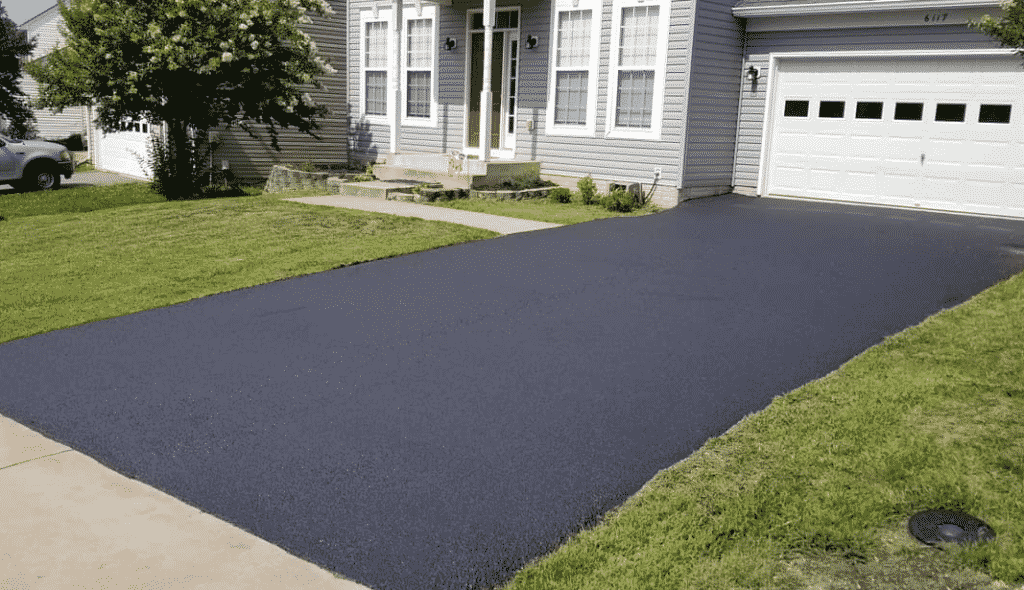Discover the Power of Business Parking Lot Leading and Asphalt Sealing
Discover the Power of Business Parking Lot Leading and Asphalt Sealing
Blog Article
Warm Mix Asphalt: A Lasting Remedy for Sidewalk
Hot Mix Asphalt (HMA) has actually arised as a leading sustainable choice for sidewalk options, providing a myriad of environmental advantages and innovative technologies. As the demand for eco-friendly building and construction practices expands, exploring the subtleties of HMA's sustainability can offer beneficial insights right into the future of pavement options.
Environmental Advantages of Warm Mix Asphalt

Additionally, Warm Mix Asphalt assists to reduce city heat island impacts. Its dark shade takes in sunlight, reducing the quantity of warmth showed back right into the environment compared to lighter-colored sidewalks. This can decrease ambient temperatures in city areas, lowering the demand for a/c and ultimately decreasing power consumption.
Additionally, Hot Mix Asphalt adds to boosted stormwater management. Its porous nature enables water to charge and penetrate the pavement groundwater supplies, decreasing overflow and the danger of flooding. These ecological benefits make Hot Mix Asphalt a sustainable selection for paving freeways and roads.
Energy Efficiency in HMA Manufacturing
Is power efficiency a critical variable in the manufacturing of Hot Mix Asphalt (HMA)? Power plays a significant duty in the production of HMA, impacting both price and ecological sustainability. One essential element of energy performance in HMA production is the use of cozy mix asphalt (WMA) modern technologies.
Moreover, developments in plant technologies have actually resulted in even more energy-efficient HMA manufacturing processes. Modern plants are made with functions like recycled asphalt sidewalk (RAP) processing abilities, effective burner systems, and enhanced insulation, all contributing to power cost savings. By maximizing power usage in HMA manufacturing, the market can reduce its carbon impact while maintaining top notch pavement products. Energy effectiveness is, therefore, a critical consideration in making certain the sustainability of Hot Mix Asphalt manufacturing.
Recyclability of Hot Mix Asphalt
The recyclability of Warm Mix Asphalt (HMA) is a crucial aspect of its sustainability and long-lasting ecological influence. HMA is one of the most recycled products in the USA, with over 100 million loads of recovered asphalt sidewalk (RAP) being recycled each year in new pavement building. Reusing HMA supplies numerous ecological benefits, such as decreasing the requirement for virgin products, reducing power intake throughout manufacturing, and decreasing the amount of waste sent to garbage dumps.
The process of recycling HMA includes grating the existing sidewalk, squashing it right into smaller sized items, and blending it with new aggregate and asphalt binder to produce a recycled mix. This recycled mix can commonly execute along with and even far better than standard HMA, while calling for less resources and producing lower greenhouse gas emissions. By including RAP right into brand-new sidewalk tasks, roadway firms can preserve natural deposits, lower prices, and lessen the ecological footprint of roadway building and upkeep activities. Generally, the recyclability of HMA plays a significant duty in advertising sustainable techniques within the pavement sector.

Long-Term Performance of HMA
Asphalt sidewalks show resilience and resilience over a prolonged duration, showing the long-lasting efficiency of Hot Mix Asphalt (HMA) In addition, innovations in HMA innovation, such as the usage of polymer-modified binders and warm mix asphalt, have actually better boosted the longevity and long life of HMA sidewalks. By focusing on top quality building and construction and maintenance practices, HMA continues to prove itself as a affordable and sustainable option for resilient pavement facilities.

HMA: Resilience and Sustainability
Demonstrating both browse around these guys durability and sustainability, Hot Mix Asphalt (HMA) has actually ended up being a foundation in the building of durable pavement facilities - commercial parking lot paving. HMA's longevity comes from its capability to endure heavy tons, rough weather, and high traffic volumes, making it a reliable option for roads, freeways, and flight terminal paths. The structure of HMA, which generally consists of accumulations, binder, and filler, plays a crucial function in boosting its durability and resistance to deterioration
Additionally, HMA's sustainability exists in its recyclability and energy-efficient manufacturing process. The ability to recycle recovered asphalt sidewalk (RAP) in new HMA combinations decreases the demand for virgin materials and reduces the environmental influence of sidewalk building and construction and upkeep. Furthermore, the power efficiency of producing HMA depends on its reduced mixing temperatures compared to various other pavement materials, leading to lowered power intake and greenhouse gas exhausts.
Conclusion
To conclude, hot mix asphalt (HMA) supplies a sustainable solution for regrading sidewalk with its eco-friendly characteristics. HMA's recyclability, energy effectiveness in manufacturing, and lasting sturdiness make it a green selection for road building. By saving all-natural sources, minimizing waste, and decreasing greenhouse gas exhausts, HMA plays an essential function in advertising sustainability in facilities development. Its capacity to minimize metropolitan warm island impacts even more underscores its relevance in developing resistant and environmentally conscious pavement systems.
HMA is one of the most recycled materials in the United States, with over 100 million lots of recovered asphalt pavement (RAP) being reused every year in brand-new sidewalk construction.The process of recycling HMA entails grating the existing pavement, squashing it into smaller pieces, and mixing it with new accumulation and asphalt binder to create a recycled mix.Asphalt sidewalks demonstrate longevity and strength over an extended duration, mirroring the long-term efficiency Clicking Here of Hot Mix Asphalt (HMA) Additionally, improvements in HMA modern technology, such as the use of polymer-modified binders and cozy mix asphalt, have additionally boosted the toughness and longevity of HMA pavements. The capability to recycle reclaimed asphalt pavement (RAP) in brand-new HMA blends reduces the demand for virgin products and minimizes the ecological impact of sidewalk building and construction and maintenance.
Report this page